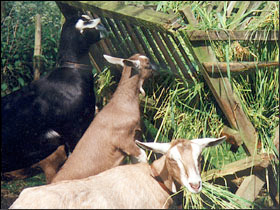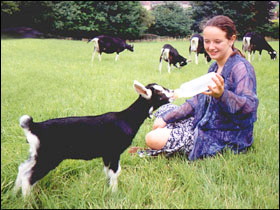For more details and references to other sources about the feeding of goats of all breeds the British Goat Society booklet “Goat Feeding” is recommended.
Some golden rules of feeding
 The aim should be to keep every goat in the herd in good bodily condition, not too thin and not too fat, all the year round.
The aim should be to keep every goat in the herd in good bodily condition, not too thin and not too fat, all the year round.
Good feeding can only be effective as part of a total package of good management, including adequate housing, exercise and health care, particularly the prevention and treatment of parasitic worm infestations.
Food must be stored properly prior to feeding, to protect it from damp, contamination and vermin.
Food must be hygienically presented to the herd with an understanding of goat behaviour so that each animal gets its share.
Good hay is the single most important item of the diet.
At least half the diet (on a dry weight basis) should consist of forage.
Green food, concentrates, minerals, vitamins and water are also important, and a balanced and adequate diet is crucial to success.
Any change to the diet fed must be made gradually to enable the population of rumen bacteria to adjust.
Kids must receive colostrum immediately after their birth, followed by a sufficient milk diet leading up to weaning.
Drinking water must be clean, fresh and always available.
It is important to establish a regular feeding routine. Take notice if any of the goats do not eat their food. All goats take a day or two to get used to a new food item, but a goat refusing an accustomed concentrate mixture is probably unwell.
Clean food and receptacles are essential. No goat will touch food or water contaminated with droppings.
Giving the correct type and quantity of food
The law, and good stockmanship, both require that livestock must receive adequate feed to keep them in good condition. It is therefore necessary to understand that much of the food eaten by a goat, and other ruminant (cud-chewing) animals, is digested by millions of bacteria in the rumen, before reaching the goat’s stomach. The good health of these bacteria is essential to the life of the goat.
Green plants consist largely of a material called cellulose, which is not digested by mammals themselves, but by the bacteria in the gut. In this way energy is converted into a form useful to the goat. Large quantities of plant food (forage) must therefore be eaten by the goat.
Additional energy is provided by eating cereal grains (e.g. oats, barley, maize) and their products. This additional energy is used to supplement the forage diet. The rumen bacteria ferment cereals very quickly, producing acid, and to feed too much grain at one time can prove fatal for the bacteria and for the goat.
The protein content of the goat’s diet also needs supplementing and this is done by adding high-protein foods (e.g. soya meal or crushed peas) in judicious quantities, to the cereal mix. Growth, pregnancy, and especially milk production, all require a greater amount of food each day than that which is required by a goat doing none of these things. The needs of each goat must be matched with the quantity, quality, availability and palatability of its daily diet. Details can be found in the booklet “Goat Feeding“, and a study of this will show that only the most nourishing of foods will support a high milk yield. The tables of feed values identifies the most nourishing foods, but “balance” is still essential.
A daily diet for a milking goat fed partly indoors, partly out in good pasture, could be:
| Foodstuff | 60 kg. Goat | 90 kg. Goat |
| Good hay | 0.5 kg. | 0.5 kg. |
| Grass | 4.3 kg. | 5.0 kg. |
| High energy goat-mix with 14% CP | 1.0 kg. | 1.3 kg. |
| Sugar beet pulp | 0.2 kg. | 0.2 kg. |
 Food tables like this are set out in “Goat Feeding” to cover different breeds and situations. As well as colostrum in the first day or two, kids require milk for at least the first three months of their lives, in addition to a gradually increasing amount of solid food.
Food tables like this are set out in “Goat Feeding” to cover different breeds and situations. As well as colostrum in the first day or two, kids require milk for at least the first three months of their lives, in addition to a gradually increasing amount of solid food.
As a guide, a typical programme for feeding kids is:
| Age of kid | Amount & Frequency |
| 0 to 1 week | 300 ml. 4 times per day |
| 1 to 2 weeks | 400 ml. 4 times per day |
| 2 to 8 weeks | Increase to 850 ml. 3 times per day |
| 9 to 10 weeks | Decrease to 850 ml. twice per day |
| 11 weeks | 500 ml. twice per day |
| 12 weeks | 500 ml. once per day |
| 13 weeks onwards | solid feeds only |

